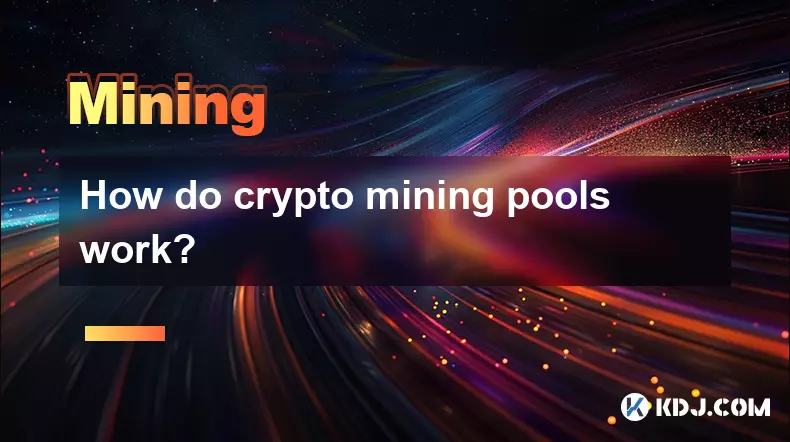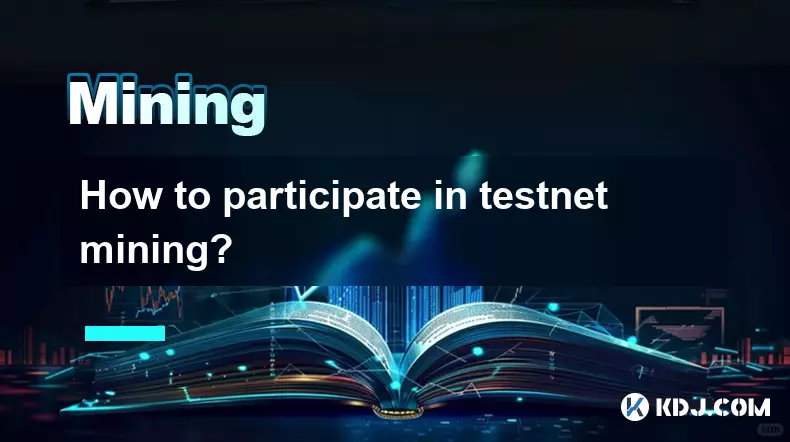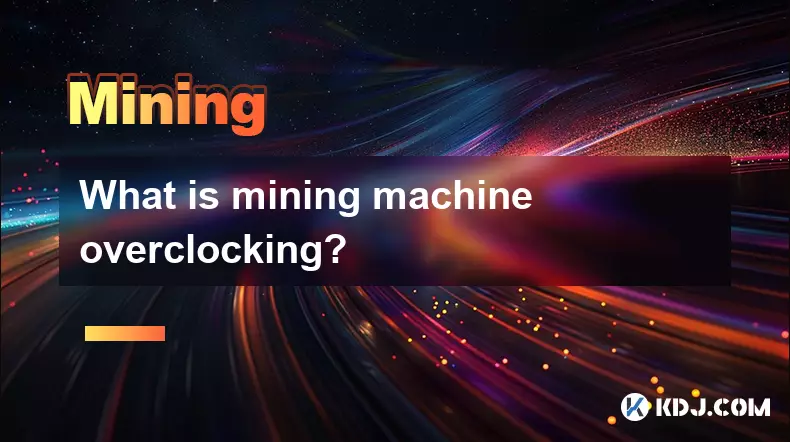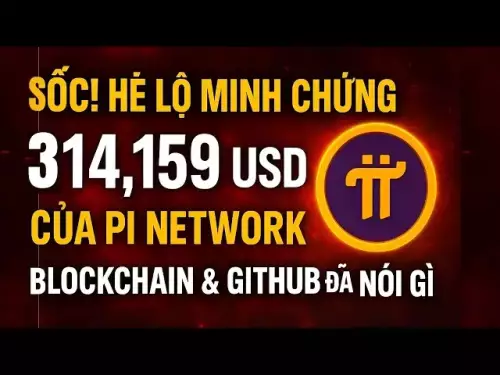-
 bitcoin
bitcoin $109547.008142 USD
0.04% -
 ethereum
ethereum $4011.838726 USD
-0.05% -
 tether
tether $1.000402 USD
-0.01% -
 xrp
xrp $2.798606 USD
0.88% -
 bnb
bnb $970.877944 USD
1.39% -
 solana
solana $202.237275 USD
-0.95% -
 usd-coin
usd-coin $0.999673 USD
0.00% -
 dogecoin
dogecoin $0.229294 USD
-1.15% -
 tron
tron $0.336370 USD
-0.45% -
 cardano
cardano $0.777260 USD
-1.66% -
 hyperliquid
hyperliquid $45.503019 USD
1.73% -
 ethena-usde
ethena-usde $1.000362 USD
0.01% -
 chainlink
chainlink $20.785303 USD
-1.10% -
 avalanche
avalanche $28.755822 USD
-0.11% -
 stellar
stellar $0.358303 USD
-0.48%
How do crypto mining pools work?
Crypto mining pools combine miners' power to boost block discovery chances, distributing rewards based on contributed work while reducing income variance.
Sep 09, 2025 at 02:36 pm

Understanding the Mechanics of Crypto Mining Pools
1. Cryptocurrency mining pools are collaborative networks where multiple miners combine their computational power to increase the likelihood of successfully mining a block. By pooling resources, participants enhance their collective hash rate, which directly impacts their chances of solving complex cryptographic puzzles required to validate transactions on a blockchain.
2. When a block is successfully mined, the reward is distributed among pool members based on their contributed computing power. This distribution is typically measured in shares, where each miner submits proof of work done toward solving the block. The more shares a miner contributes, the larger their portion of the reward.
3. Mining pools operate using specialized software that coordinates tasks between the server and individual miners. The pool operator runs a server that assigns work units to connected miners and verifies the shares they return. This infrastructure ensures fairness and prevents double submission or cheating.
4. Different reward systems are used by pools to distribute earnings. Common models include Pay-Per-Share (PPS), where miners are paid for each valid share regardless of block discovery, and Proportional (PROP), where rewards are distributed only after a block is found, based on the number of shares submitted during that mining round.
5. Pools reduce the variance in income for individual miners, especially those with limited hardware capabilities. Instead of waiting potentially months to mine a block independently, participants in a pool receive smaller but more frequent payouts, creating a steadier revenue stream.
How Rewards Are Distributed Among Miners
1. The distribution of rewards depends heavily on the chosen payout scheme. In the Pay-Per-Last-N-Shares (PPLNS) model, rewards are calculated based on the last N shares submitted before a block is found, incentivizing consistent participation rather than short bursts of activity.
2. Some pools use a score-based system where recent shares are weighted more heavily than older ones. This approach discourages miners from switching pools mid-round to chase higher short-term gains, promoting stability within the network.
3. Transparency is critical in reward distribution. Reputable mining pools provide real-time dashboards showing hash rate contributions, accepted and rejected shares, and estimated payouts. This visibility helps build trust between the pool operator and participants.
4. Fees are typically deducted from the total block reward before distribution. These fees vary between pools, usually ranging from 1% to 3%, and cover operational costs such as server maintenance, bandwidth, and administrative overhead.
5. Miners must configure their wallets correctly to receive payouts. Most pools allow users to set minimum payout thresholds, meaning funds are only transferred once a certain balance is reached, reducing transaction fees and blockchain congestion.
Security and Risks Associated with Mining Pools
1. Centralization poses a significant risk in the mining ecosystem. When a single pool accumulates more than 50% of the network’s hash rate, it gains the potential to execute a 51% attack, allowing it to reverse transactions or prevent new ones from being confirmed.
2. Pool hopping is another concern, where miners switch between pools strategically to maximize profits without contributing fairly to any one pool. Certain reward systems like PPLNS are designed to mitigate this behavior by rewarding sustained participation.
3. Trust in the pool operator is essential. Dishonest operators could theoretically manipulate share counting or withhold rewards. To minimize this risk, open-source pool software and community-audited platforms are preferred by many miners.
4. Downtime or technical failures on the pool’s server can disrupt mining operations, leading to lost shares and reduced earnings. Reliable pools invest in redundancy, backup systems, and low-latency connections to maintain uptime.
5. Individual miners also face risks such as IP exposure and potential targeting by attackers. Using secure connections like SSL/TLS when connecting to pool servers helps protect sensitive data and maintain privacy.
Frequently Asked Questions
What happens if a miner disconnects during a mining round?If a miner disconnects, they stop submitting shares and no longer contribute to the current round. Upon reconnection, they resume work on the latest task assigned by the pool. Any shares submitted before disconnection are still counted if they were accepted by the server prior to the outage.
Can a mining pool operator steal my cryptocurrency?A pool operator cannot directly access a miner’s private keys or wallet funds. However, they control the distribution of rewards. Choosing a well-established, transparent pool with verifiable payout records reduces the risk of fraud. Always research the operator’s reputation before joining.
Are there alternatives to joining a mining pool?Yes, solo mining is an option where individuals attempt to mine blocks independently. However, due to the high difficulty levels on major blockchains like Bitcoin, solo mining is rarely profitable unless the miner possesses a massive amount of computational power.
How do I choose the right mining pool?Consider factors such as the pool’s fee structure, payout method, server location (to minimize latency), uptime history, and community reputation. Smaller pools may offer more decentralization benefits, while larger pools provide more consistent payouts.
Disclaimer:info@kdj.com
The information provided is not trading advice. kdj.com does not assume any responsibility for any investments made based on the information provided in this article. Cryptocurrencies are highly volatile and it is highly recommended that you invest with caution after thorough research!
If you believe that the content used on this website infringes your copyright, please contact us immediately (info@kdj.com) and we will delete it promptly.
- Altcoin Season Heats Up: Is ARB, PEPE, or a New Challenger Your Best Bet?
- 2025-09-28 10:25:11
- Shiba Inu, Meme Coins, and Popularity: What's Hot and What's Not in the Wild World of Crypto
- 2025-09-28 10:25:11
- Cardano, Toncoin, and the Quest for Crypto's Next Big Thing
- 2025-09-28 10:45:12
- XRP, Ripple, and the Payment Token Race: What's Next?
- 2025-09-28 10:45:12
- MoonBull Mania: Is This the Next Bonk in the Cryptoverse?
- 2025-09-28 10:30:00
- Bitcoin's 'Uptober' Hopes Clash with Selling Pressure: A New Yorker's Take
- 2025-09-28 10:50:01
Related knowledge

The difference between staking and mining
Sep 24,2025 at 05:18am
Understanding Staking in the Cryptocurrency Ecosystem1. Staking involves holding funds in a cryptocurrency wallet to support the operations of a block...

How to participate in testnet mining?
Sep 22,2025 at 09:18am
Understanding Testnet Mining in the Crypto Ecosystem1. Testnet mining is a method used by blockchain developers to simulate real-world conditions on a...

How to dispose of abandoned mining machines?
Sep 19,2025 at 08:19pm
Assessing the Condition of Abandoned Mining Rigs1. Begin by inspecting each mining machine for visible damage, corrosion, or missing components. Machi...

How to identify high-quality mining pools?
Sep 21,2025 at 03:19pm
Reputation and Track Record1. A mining pool’s reputation is built over time through consistent performance and transparency. Pools that have operated ...

Advantages of decentralized mining pools
Sep 20,2025 at 04:36pm
Enhanced Security and Resistance to Censorship1. Decentralized mining pools operate on blockchain-based smart contracts, eliminating the need for a ce...

What is mining machine overclocking?
Sep 21,2025 at 07:19pm
Understanding Mining Machine Overclocking1. Mining machine overclocking refers to the process of increasing the operating frequency of a cryptocurrenc...

The difference between staking and mining
Sep 24,2025 at 05:18am
Understanding Staking in the Cryptocurrency Ecosystem1. Staking involves holding funds in a cryptocurrency wallet to support the operations of a block...

How to participate in testnet mining?
Sep 22,2025 at 09:18am
Understanding Testnet Mining in the Crypto Ecosystem1. Testnet mining is a method used by blockchain developers to simulate real-world conditions on a...

How to dispose of abandoned mining machines?
Sep 19,2025 at 08:19pm
Assessing the Condition of Abandoned Mining Rigs1. Begin by inspecting each mining machine for visible damage, corrosion, or missing components. Machi...

How to identify high-quality mining pools?
Sep 21,2025 at 03:19pm
Reputation and Track Record1. A mining pool’s reputation is built over time through consistent performance and transparency. Pools that have operated ...

Advantages of decentralized mining pools
Sep 20,2025 at 04:36pm
Enhanced Security and Resistance to Censorship1. Decentralized mining pools operate on blockchain-based smart contracts, eliminating the need for a ce...

What is mining machine overclocking?
Sep 21,2025 at 07:19pm
Understanding Mining Machine Overclocking1. Mining machine overclocking refers to the process of increasing the operating frequency of a cryptocurrenc...
See all articles










































































